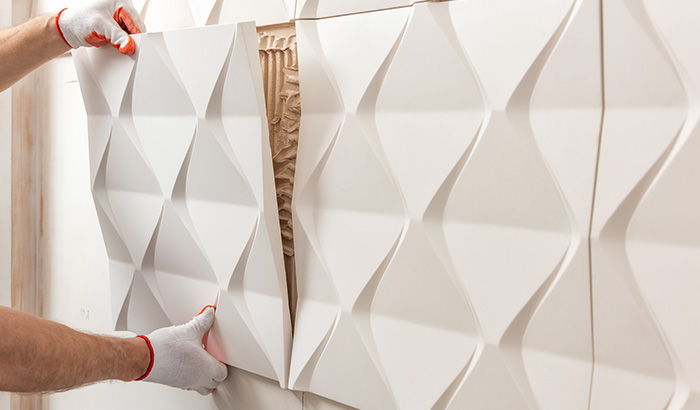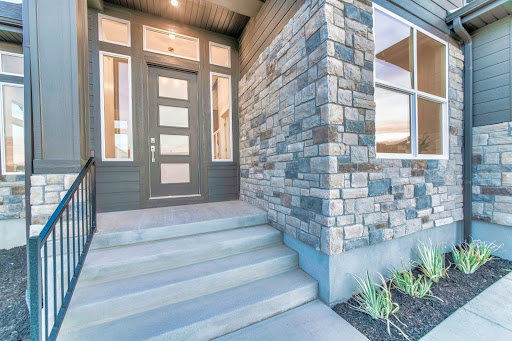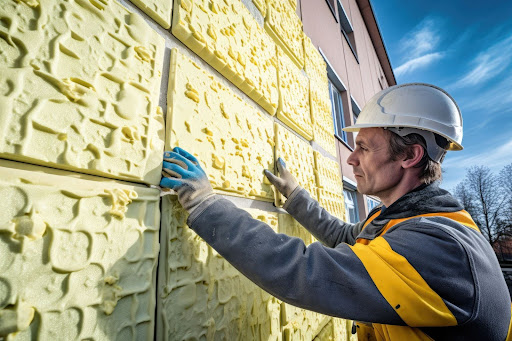Wall panels are quietly revolutionizing how we approach building projects and streamlining the entire building process.
Most of the wall manufacturing process takes place in a controlled environment, separate from the actual building site. This shift speeds up the overall construction time and adds a level of precision previously unseen in traditional methods. This innovation is capturing the attention of industry professionals and clients alike, opening up new avenues in design, efficiency, and cost management.
In this blog, we will explore the ins and outs of wall panels and why they’re making a big impact in the construction world. Whether you’re in the industry or simply fascinated by how buildings come together, you’ll discover why wall panels are the path to smarter, faster, and more efficient building construction.
What are wall panels?
Wall panels are an ingenious innovation in modern construction. Initially, panels were simple, rudimentary structures used for basic partitioning and insulation. However, as technology and materials advanced, wall panels evolved into sophisticated components of modern architecture. This evolution is driven by the industry’s pursuit of more efficient, cost-effective, and versatile building methods.
Prefabricated panels
Today, the most dynamic prefabricated wall panels are made from cold-formed steel (CFS) and provide structural support, insulation, and aesthetic value all at once. Depending on the needs of your project, there are three types of prefabricated panel systems to choose from.
Kit of parts
These are custom-designed and manufactured wall framing systems. CFS studs and tracks are manufactured according to the exact dimensions of the plan. Then, they are delivered in a pre-packaged kit ready to assemble onsite.
A kit of parts is perfect for projects that require framing inside an existing structure, such as Tennent Improvements (TI), or projects with limited or difficult access.
Similar to how you would follow instructions to assemble an erector set, these systems are like a home or building delivered with plans that instruct the construction and assembly.
Framed wall panels
These prefabricated wall panels are also custom-designed, manufactured, and assembled framing packages delivered to a site. However, framed wall panels arrive in complete sections that are ready to be installed without additional steps to assemble.
Once the panels are installed, they still require external sheathing of some kind. Some projects require a specific, uniform, finished look that is easily created over the framed wall panels.
Finished wall panels
If your project allows for them, finished wall panels are the most complete systems available. Beyond being custom-designed and manufactured, the assembled framing packages are delivered to the site with exterior finishes (metal panels, EFIS, brick veneer, etc.) already applied.
As long as there is consistent collaboration between all the steps of design and construction, finished wall panels provide the most cut-and-dry solution for wall panels.
Cost-effectiveness
One of the areas where wall panels save money is labor costs. Traditional construction methods require multiple stages, each needing skilled labor — framing, insulating, and finishing the walls. This process is time-consuming and labor-intensive.
Wall panels cut the cost of labor by arriving pre-assembled. The on-site assembly of these panels is quicker and needs less manpower. This reduces labor costs, especially in large-scale projects.
Then there’s the aspect of efficient use of materials. Cutting and shaping materials on a typical construction site leads to a fair bit of wastage. Manufactured wall panels come from controlled factory settings where the use of materials is optimal and leaves minimal leftovers.
Wall panels are a practical option for initial construction budgets and ongoing building maintenance costs.
Energy efficiency
Wall panels are making a significant impact by enhancing energy efficiency. This aspect of wall panels is especially impactful for the growing focus on sustainable building practices.
The core feature of wall panels that contributes to energy savings is their exceptional insulation. Take CFS panels, for example. They are designed to keep the building warm in the colder months and cool during the summer. This level of insulation means that the building’s heating and cooling systems don’t have to work as hard, leading to a noticeable decrease in energy consumption and, consequently, energy bills.
But, the implications of using these energy-efficient materials go beyond saving money. In a world increasingly conscious of its carbon footprint, the reduced energy consumption of buildings with wall panels is a big step in the right direction.
Choosing wall panels means investing in a solution that offers immediate energy cost savings and contributes to a more sustainable future.
Design flexibility and aesthetics
Wall panels offer an incredible array of options for architects and interior designers. Their versatility in design enables a creative freedom that was once hard to achieve in traditional construction. You can choose from a diverse range of textures, colors, and materials for an extraordinary level of customization.
Whether the aim is to create a modern, sleek look or to evoke a more classic, traditional style, wall panels rise to the occasion. They even mimic the appearance of materials like brick, stone, or wood, offering the aesthetic qualities of these materials but with greater durability and easier installation.
Beyond the aesthetic appeal, wall panels are also incredibly adaptable in terms of functionality. You can tailor them to suit different building styles and specific architectural needs.
For instance, wall panels are designed to be both slim and strong to meet the needs of small spaces. They provide essential support without eating into valuable space.
Well-chosen wall panels become statement pieces in a room, offering unique and stylish solutions for feature walls or creative designs that add personality and flair to an interior space.
Durability and strength
When it comes to building materials, durability and strength are imperative. This is where wall panels truly stand out. They’re built to handle the rigors of various environmental conditions, ensuring that buildings stay sturdy and intact, especially in areas prone to extreme weather.
Wall panels have a special edge when dealing with moisture, which is a big headache in construction. Traditional building methods often leave room for moisture to seep in, leading to issues like mold or structural weakening. Wall panels help keep moisture out and ensure the structure’s longevity.
Pests, like termites, wreak havoc on buildings, especially those with a lot of wood. Wall panels, particularly those made from composite materials, are much less attractive to these pests.
Fire resistance is another key aspect of wall panels. In today’s construction world, having materials that slow down the spread of fire is vital. Many wall panels come with fire-resistant properties, providing crucial extra time for evacuation and response in case of a fire.
Ease of installation
Installing wall panels is easier than ever, particularly considering the speed and convenience it brings to the building process. Let’s take a closer look at how this works and why it’s such an advantage.
Wall panels are created in a factory setting, where they’re crafted to exact specifications. This process includes fitting in elements like windows, doors, and necessary insulation and wiring. Once these panels are ready, they’re transported to the building site, where the real efficiency comes into play.
The streamlined nature of wall panel installation means the construction is quicker and more predictable. Delays often seen in traditional construction methods due to various on-site challenges are largely avoided.
Collaboration and design coordination
Incorporating prefabricated wall panels into your project emphasizes the importance of meticulous design coordination. Collaborating closely with your project’s design team will ensure the dimensions of the wall panels are accurate. This collaboration involves detailed planning and communication.
The process also involves a thorough review of architectural drawings and regular consultations between the design team and the panel manufacturers. This ensures that every detail is accounted for and that the panels, once installed, will integrate perfectly with other building components.
Every aspect of the wall panels — from size and shape to the placement of doors, windows, and other structural elements — must align perfectly with your project’s overall design and structural requirements.
Effective design coordination means that the architects, engineers, and construction professionals work to share insights and adjustments in real time. Even a minor miscalculation in the dimensions might lead to significant issues during installation. This could potentially offset all the benefits that prefabricated panels bring.
By prioritizing this collaboration, you ensure that the panels fit seamlessly into your project, complementing the building’s architectural vision and structural integrity.
Challenges and considerations
Despite its many advantages, adopting wall panel construction comes with its own challenges and important considerations. Be aware of these in order to integrate wall panels into your building projects effectively.
Navigating building codes is one of the main challenges. These regulations differ from place to place and are critical for ensuring construction safety and quality. Wall panels, particularly those that are more innovative or unconventional, might not always align seamlessly with these established codes.
It’s vital to ensure that the wall panels you choose are compliant with local regulations. Doing this might involve extra steps like seeking special approvals or making specific adjustments to the panels.
The climate of the area where you’re building is another important factor. Different wall panel materials react differently to various environmental conditions.
For example, in areas with high humidity or extreme temperatures, select wall panels can withstand these extremes. Using the right wall panels ensures the panels’ durability and maintains the building’s efficiency.
Sustainable solutions from Salt Lake Prefab
Wall panels from Salt Lake Prefab are engineered with precision and designed to add aesthetic value to any structure, be it residential, commercial, or industrial.
What sets Salt Lake Prefab apart is our commitment to sustainability. We use eco-friendly materials and practices in our manufacturing process, ensuring that your project is structurally sound and environmentally conscious. With our tailor-made approach, we provide wall panels that enhance your buildings’ structural integrity and energy efficiency.
When you choose Salt Lake Prefab, you’re opting for a seamless, sustainable building experience. Call us at 385-557-6800 or contact Salt Lake Prefab online. Let’s build something great together!



